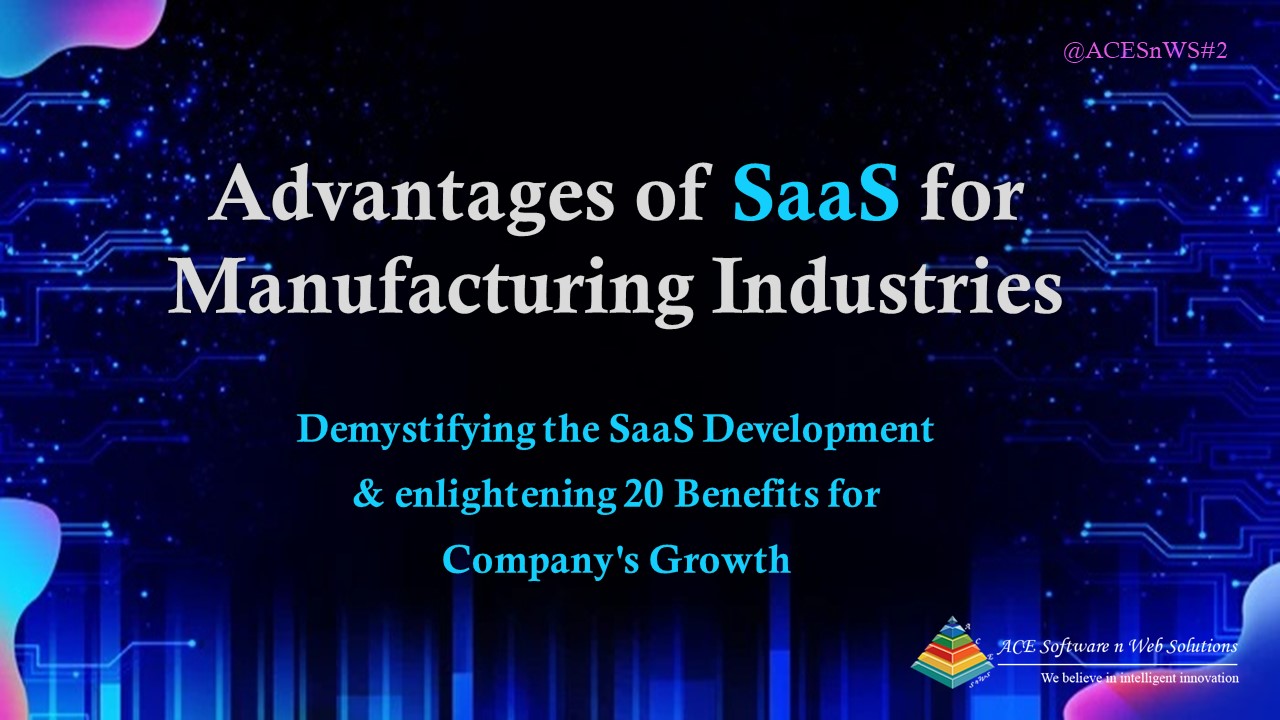
Advantages of SaaS for Manufacturing Industries
Manufacturing industries are undergoing a significant transformation, driven by the need for agility, efficiency, and staying competitive in a rapidly evolving landscape. One powerful solution that can empower manufacturing companies to meet these challenges head-on is the development of Software as a Service (SaaS) solutions tailored to their unique needs. In this article, we demystify the advantages of SaaS development to thrive in today’s fast-paced business environment, boosting productivity, reducing costs, driving growth and explore why it’s crucial for manufacturing industries to embark on this journey for their own betterment.
In my previous article, we explored a comprehensive guide to development strategies for Manufacturing Industries for Unlocking the Power of SaaS. If you missed reading that, here’s a quick link to refer to it before you dive into reading this article Unlocking the Power of SaaS: A Comprehensive Guide to Development Strategies for Manufacturing Industries
Key Challenges Faced
In our conversations with various teams in the manufacturing industry, from top-level executives to ground workers, we have identified 10 key challenges that impact their operations, growth, and competitiveness.
- Supply Chain Disruptions: Global events, such as the COVID-19 pandemic and natural disasters can disrupt the supply chain, leading to material shortages and delayed production. Many manufacturers have complex supply chains spanning multiple countries and suppliers, coordinating these networks efficiently and ensuring reliability becomes a major challenge
- Quality Control and Assurance: Maintaining consistent product quality is essential, and deviations can lead to costly recalls and damage to a company’s reputation
- Product Customization: Meeting consumer demands for highly customized products while maintaining efficiency manufacturers need flexible production processes and the ability to respond quickly to changing customer preferences
- Raw Material Costs: Fluctuating prices of raw materials can impact production costs and profitability, making it challenging to maintain stable pricing
- Cost Pressure: The pressure to reduce costs while maintaining quality, this includes managing labour, raw material, and operational costs effectively
- Labour Shortages: A shortage of skilled labour, especially in advanced manufacturing, can hinder productivity and lead to increased labour costs
- Regulatory Compliance: Meeting industry-specific regulations, safety standards, and environmental requirements can be complex and costly
- Environmental Sustainability: Balancing production demands with environmental sustainability goals, including waste reduction and energy efficiency, presents a challenge
- Global Competition: Competing with manufacturers worldwide requires efficiency, innovation, and cost-effectiveness to maintain market share
- Cybersecurity Threats: Protecting sensitive data and intellectual property from cyberattacks is essential to prevent costly data breaches and disruptions
20 Advantages of Developing a SaaS for a Company’s Growth
- Tailored Solutions – Design a SaaS solution tailored to your specific manufacturing needs, from supply chain management to production control. Create a modular structure for easy updates and scalability, allowing for future adaptations
- Cost Savings – Reduce capital expenditure by eliminating the need for on-premises servers and infrastructure, lower maintenance costs by outsourcing it to a SaaS development agency reducing maintenance, updates and IT overheads
- Scalability – Easily adapt to changes in production demands without heavy investments in hardware or software upgrades as well as scaling your SaaS solution to support international operations and growth.
- Accessibility and Collaboration – Enable employees to access critical data and applications from anywhere, promoting remote work and collaboration and fostering collaboration with suppliers, distributors, and partners through real-time data sharing
- Data Analytics – Utilize sensors and IoT devices to collect real-time data for predictive maintenance and quality control and implement machine learning algorithms for predictive analytics and process optimization, boosting efficiency
- Integration – Seamlessly integrate your SaaS solution with existing Enterprise Resource Planning (ERP) systems, ensuring data continuity and enabling machines to communicate autonomously, streamlining production processes using Machine-to-Machine (M2M) Communication
- Quality Control – Implement stringent quality control checks at every production stage, ensuring high-quality products using rigorous inspection methods to identify and rectify defects in real-time, minimizing product recalls and associated costs
- Inventory Management – Manage inventory efficiently, preventing overstock or understock situations, and optimizing cash flow
- Supply Chain Efficiency – Gain real-time visibility into your supply chain, allowing for quick response to disruptions and optimize supplier relationships and logistics, reducing overall supply chain costs
- Security and Compliance – Ensure data security through robust encryption methods, safeguarding proprietary information and adhering to industry-specific regulations such as ISO standards or FDA guidelines
- Mobile Accessibility – Develop mobile applications for remote monitoring and control of manufacturing processes, implementing AR for remote troubleshooting, training and reducing downtime
- Cloud Architecture – Opt for cloud services that can scale automatically to ensure high availability and minimize downtime risks to meet fluctuating production demands
- Collaborative Decision-Making – Access to real-time data facilitates informed decision-making across the organization
- Global Accessibility – A SaaS provides anywhere, anytime access, enabling executives and managers to access critical information and make decisions regardless of location
- Enhanced Customer Experience – Use data analytics to respond rapidly to customer demands and preferences, improving customer satisfaction
- Competitive Advantage – Stand out in the market by adopting flexible, future-ready SaaS solutions uniquely created to fulfil your needs, offering streamlined production processes, reduced lead times and faster order fulfilment
- Production Efficiency: Achieve a 15% to 20% increase in production efficiency through the implementation of SaaS solutions using real-time data analytics and machine-to-machine communication
- Inventory Holding Costs: Effective SaaS-driven inventory management can lead to a 15% reduction in inventory holding costs, optimizing cash flow and resulting in a significant improvement in on-time delivery performance, with up to 25% increase
- Customer Satisfaction: 15% increase in customer satisfaction by using data analytics to respond rapidly to customer demands and preferences
- Decision Making: SaaS solutions provide real-time data access for informed decision-making, contributing to a 10% to 15% improvement in the quality and speed of decision-making processes
In a world where manufacturing processes are becoming increasingly automated and data-driven, these industries have much to gain from developing their own SaaS solutions. These solutions are cost-effective, offer customization as per your requirements and scalable tools enhance accessibility, data analytics, and collaboration. By adopting a SaaS approach, manufacturing companies can unlock an array of benefits that drive growth, streamline operations, and secure their future in an ever-evolving business landscape.


